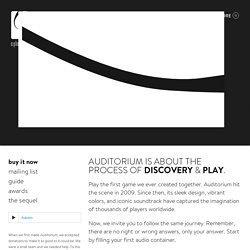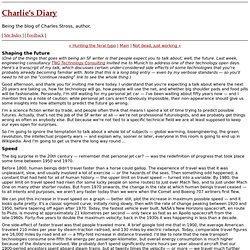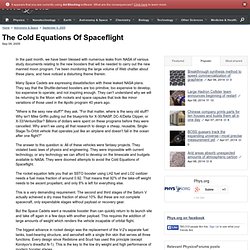

Paranormal. Height. Squidsoup.org home. Play Auditorium. Play the first game we ever created together.

Auditorium hit the scene in 2009. Since then, its sleek design, vibrant colors, and iconic soundtrack have captured the imagination of thousands of players worldwide. Now, we invite you to follow the same journey. Remember, there are no right or wrong answers, only your answer. Start by filling your first audio container. Click the game area, turn up your speakers, and relax. Ws point north thanks to in-built compasses. Very pleasing video of five metronomes syncing together. 11 phenomenal images of earth « deputydog. ZBIG VISION - research, development and production of visual arts. Dr Quantum - Double Slit Experiment.
Xkcd - A webcomic of romance, sarcasm, math, and language - By Randall Munroe. Charlie's Diary: Shaping the future. Good afternoon, and thank you for inviting me here today.

I understand that you're expecting a talk about where the next 20 years are taking us, how far technology will go, how people will use the net, and whether big shoulder pads and food pills will be fashionable. Personally, I'm still waiting for my personal jet car — I've been waiting about fifty years now — and I mention this as a note of caution: while personal jet cars aren't obviously impossible, their non-appearance should give us some insights into how attempts to predict the future go wrong.
I'm a science fiction writer by trade, and people often think that means I spend a lot of time trying to predict possible futures. Actually, that's not the job of the SF writer at all — we're not professional futurologists, and we probably get things wrong as often as anybody else. But because we're not tied to a specific technical field we are at least supposed to keep our eyes open for surprises. Speed. Levitated Daily Source, the good source. The Biology of B-Movie Monsters. How to Build a Universe That Doesn't Fall Apart Two Days Later.
First, before I begin to bore you with the usual sort of things science fiction writers say in speeches, let me bring you official greetings from Disneyland. I consider myself a spokesperson for Disneyland because I live just a few miles from it—and, as if that were not enough, I once had the honor of being interviewed there by Paris TV. For several weeks after the interview, I was really ill and confined to bed. The Solar System. All the water and all the air. Moonbow - Lunar Rainbow. The Cold Equations Of Spaceflight. In the past month, we have been blessed with numerous leaks from NASA of various study documents relating to the new boosters that will be needed to carry out the new manned moon program.

I've been monitoring the large volume of Web chatter about these plans, and have noticed a disturbing theme therein. Many Space Cadets are expressing dissatisfaction with these leaked NASA plans. They say that the Shuttle-derived boosters are too primitive, too expensive to develop, too expensive to operate, and not inspiring enough. They can't understand why we will be returning to the Moon with rockets and space capsules that look like minor variations of those used in the Apollo program 40 years ago.
Home Page for Proboscis. Neave Lab › Flash Earth. Did you ever wonder what it would be like to see a water balloon pop in space? During Dr.

Donald Pettit's nearly six-month flight (from November 2002 – May 2003) on-board the International Space Station, he conducted many experiments and demonstrations for the Saturday Morning Science Program. His “Symphony of Spheres” is an excellent illustration of the fluid physics experiments that can be performed in microgravity, as opposed to a 1-g, low-gravity environment. Don's comments about his “Symphony of Spheres” included: “Created inside the air bubble were a half-dozen or so small spherical droplets of water, one to four millimeters in diameter, orbiting around like a miniature solar system. … This motion appeared almost life-like so that for a minute I thought we were looking through a magnifier at some new form of creatures zooming around inside of a three-dimensional Petri dish. … Of all the things on orbit I have seen to date, this is by far the most amazing.”
Click here to read the full article: Computers in Space. Spaceships portrayed in the movies have vastly complicated computers running them.

Databanks brimming over with the sum knowledge of human (or alien) kind within them. But as we know, life rarely imitates art, and none so more the case as real-life space computing. Why is it, that at a time where you can go and buy a machine that is several thousands of times more powerful than the sum computing capability of NASA at the time of the Apollo moon shots, does the space industry lob hardware up there that’s only marginally faster than an old 386? Let’s find out. And no, before you ask, it’s not to stop infiltration by attractive looking clones and walking toasters. Lab › Space › Planetarium.